Journey into the biblical narrative to uncover the complex and controversial role of harems, a topic that challenges and intrigues.
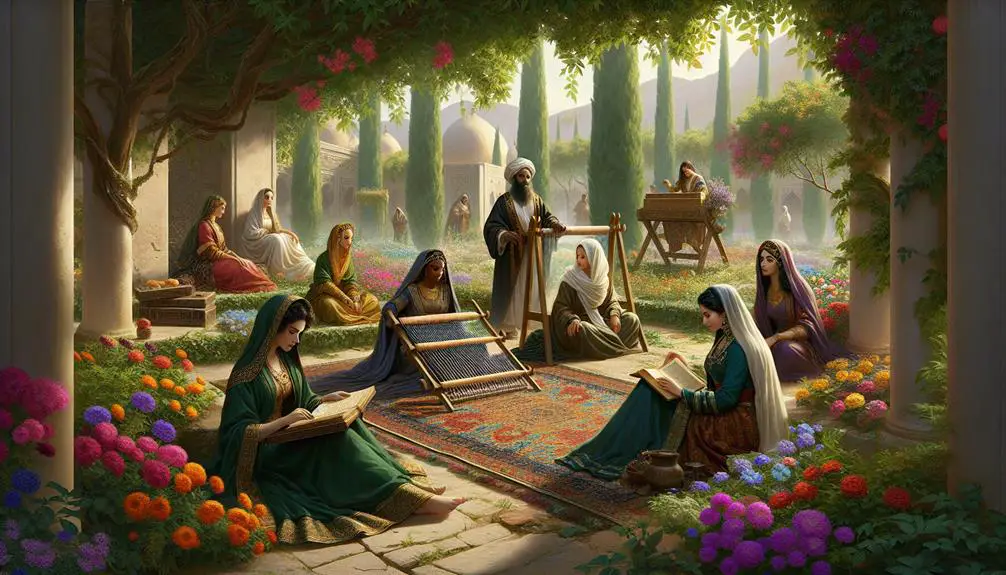
Harem in the Bible
Interestingly, you may find that the concept of harems, often associated with Eastern cultures, makes its unexpected appearance in the biblical narrative as well.
As you explore the intricate dynamics of Solomon's grand harem, among others, you'll uncover a complex web of social, familial, and political implications that these arrangements held within ancient societies.
The discussions surrounding these biblical figures and their harems open up a myriad of interpretations and debates that not only shed light on historical practices but also challenge our understanding of moral and ethical standards of the time.
This intriguing juxtaposition invites you to consider the broader implications and the enduring legacy of these ancient practices in today's discourse.
Key Takeaways
- Harems in biblical times symbolized wealth, power, and political alliances through strategic marriages.
- Gender dynamics within harems reflect societal norms, with significant roles for wives, concubines, and children in inheritance and status.
- Biblical stories of figures like Solomon illustrate the complex interplay between faith, morality, and the practice of maintaining harems.
- Scholarly debates continue over the historical accuracy and ethical implications of harems as depicted in biblical contexts.
Definition and Origins

The concept of a harem, often associated with notions of seclusion and privilege, finds its intricate origins in ancient societal structures and religious texts, including those of the Bible. You'll find that the term 'harem' itself, though not explicitly mentioned in the Bible, is implicit in several narratives, reflecting a space reserved for the women of the household, including wives, concubines, and female servants. This structure served not only as a living space but also as a complex social system, delineating the relationships and hierarchies among the women and their relationship to the patriarch.
In drawing cultural comparisons, it's evident that harems weren't unique to the Biblical era or locale. Similar concepts existed in various forms across ancient civilizations, including the Ottoman Empire and Imperial China, suggesting a universal approach to managing and organizing the intimate aspects of power and familial lineage.
Modern parallels can be found in the continuing fascination with exclusivity and privacy among the elite, though the context and manifestations have evolved. The historical concept of the harem, thus, offers a lens through which one can explore the dynamics of gender, power, and society across time and culture, highlighting the adaptability and persistence of such social structures.
Solomon's Grand Harem
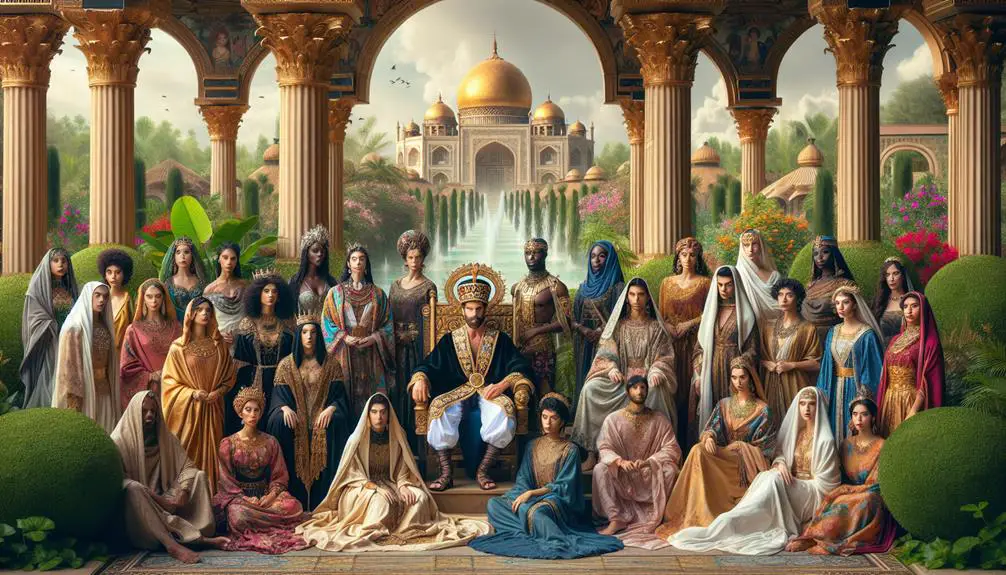
CURRENT SUBTOPIC: 'Solomon's Grand Harem'
King Solomon's grand harem, encompassing 700 wives and 300 concubines, serves as a profound illustration of the complexities inherent in ancient Near Eastern societal structures and the pivotal role of gender dynamics within them. This expansive harem wasn't merely a symbol of opulence but reflected Solomon's strategic alliances through marriages, showcasing his wisdom in maintaining peace and extending his influence. Moreover, Solomon's harem had a significant impact on his architectural contributions, necessitating the construction of an elaborate palace complex to accommodate his vast household.
Aspect |
Impact on Society |
|---|---|
Strategic Marriages |
Solidified political alliances, extending Solomon's influence |
Gender Dynamics |
Highlighted the role of women in diplomatic relationships |
Architectural Contributions |
Led to the development of extensive palace complexes |
Solomon's Wisdom |
Demonstrated in managing a complex household and kingdom |
Cultural Exchange |
Fostered through the diverse origins of the harem members |
Solomon's harem, therefore, wasn't just a personal choice but a reflection of his political acumen and the sociopolitical fabric of the time.
Other Biblical Figures
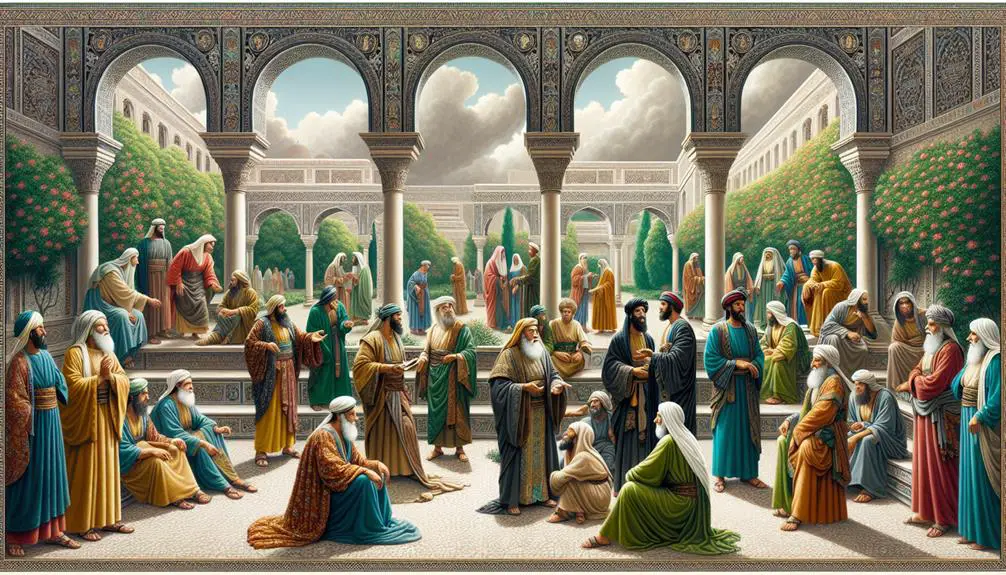
Exploring beyond Solomon, other biblical figures also engaged in practices that reflect the intricate social and political landscapes of their times. While Solomon's grand harem is often spotlighted, the presence and implications of similar arrangements in the lives of other characters warrant a closer examination. These instances aren't merely historical footnotes; they're deeply woven into the fabric of moral controversies and prophetic narratives, offering nuanced insights into the societal norms and challenges of their eras.
- Abraham and Sarah: This couple's story introduces the complexity of concubinage and its implications on familial and social dynamics, highlighting themes of faith, promise, and the consequences of human actions.
- David: A king celebrated for his military might and poetic prowess, David's relationships and the political alliances they forged are central to understanding the moral and ethical quandaries of his time.
- Jacob: His marriages and subsequent family dynamics illustrate the interplay between personal choices and divine promises, offering a rich field for exploring themes of love, deception, and the pursuit of destiny.
These narratives, embedded with lessons on power, faith, and morality, challenge readers to consider the delicate balance between divine commandments and human actions within the context of their times.
Social Implications

You'll find that exploring the concept of harems within the biblical context sheds light on intricate gender dynamics and reveals underlying power structures.
These elements not only reflect the societal norms of ancient times but also offer insights into the enduring nature of human relations.
Understanding these dynamics allows you to appreciate the complexity of biblical narratives and their relevance to contemporary discussions on gender and power.
Gender Dynamics Explored
In analyzing the concept of harems within biblical narratives, it becomes evident how gender dynamics significantly influenced social structures and relationships. This exploration reveals:
- Modern parallels where similar gender imbalances persist in societal and organizational structures, highlighting the cultural impact of historical narratives on contemporary issues.
- The role of gender in defining power and status within these ancient societies, showcasing how deeply entrenched gender roles were in shaping social hierarchies.
- The intricate ways in which these narratives intersect with and reinforce societal norms and expectations regarding gender roles, emphasizing the complexity of navigating gender dynamics in any era.
Power Structures Unveiled
Delving into the power structures of biblical times reveals how harems not only symbolized wealth and status but also played a pivotal role in shaping societal norms and hierarchies. You'll find that the existence and management of harems directly influenced cultural mores and religious interpretations, highlighting a complex interplay of power within ancient societies.
Aspect |
Impact on Society |
Relation to Harems |
|---|---|---|
Wealth |
Symbol of Prosperity |
Harems as Status Symbols |
Gender Dynamics |
Enforced Patriarchy |
Control and Ownership |
Religious Interpretation |
Justified Authority |
Aligning with Divine Order |
Cultural Mores |
Shaped Norms |
Harems as Cultural Institutions |
This table showcases the intricate ways in which harems were woven into the fabric of society, underpinning and reflecting the power structures that existed.
Familial Dynamics
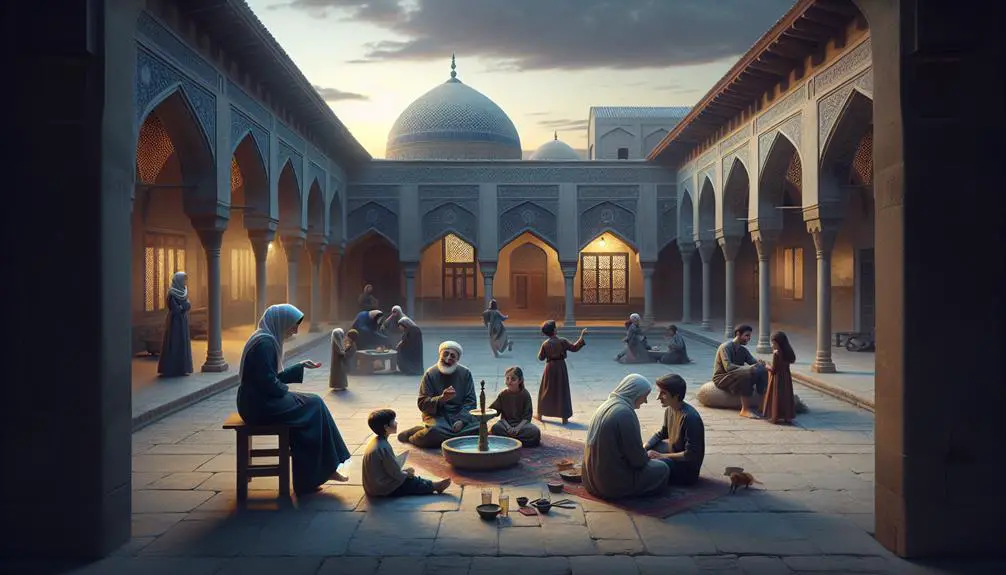
You must consider how the patriarchal household structure influenced the roles and statuses within Biblical harems. Wives and concubines had distinctly defined roles, impacting the social and familial hierarchy directly.
Similarly, children's hierarchical status was deeply entwined with their mother's position, shaping their future and societal standing.
Patriarchal Household Structure
Analyzing the patriarchal household structure reveals a system where males, typically the eldest, held authority and governance over family matters, shaping the familial dynamics within biblical contexts. This structure had significant implications on the social fabric of the time, particularly in terms of:
- Economic stability: The head of the household managed resources and wealth, ensuring the family's survival and prosperity.
- Legal implications: Males were responsible for making legal decisions and representing the family in public and judicial affairs.
- Social hierarchy: This system reinforced a social order where males were dominant, affecting the roles and status of family members.
Understanding this structure is crucial for comprehending the complex interplay of power, responsibility, and social norms that characterized family life in biblical times.
Wives and Concubines Roles
In the patriarchal household structure of biblical times, wives and concubines played distinct but interconnected roles that were pivotal to family dynamics and social stratification. Wives, bound by the sanctity of marriage, were expected to uphold the highest standards of marital fidelity. Their roles extended beyond bearers of legitimate heirs to include significant economic responsibilities within the household. They managed domestic affairs and, in some instances, engaged in activities that contributed to the family's economic standing.
Conversely, concubines, while also integral to the family structure, occupied a more ambiguous position. Lacking the formal status of wives, they nonetheless bore children and performed household duties. Their presence underscores the complex interplay between social status, economic contributions, and familial loyalty in biblical familial dynamics.
Children's Hierarchical Status
Children's positions within the biblical family structure were deeply influenced by their mothers' status as either wives or concubines, establishing a hierarchical dynamic that shaped their social and familial roles. This status had profound implications on:
- Inheritance Laws: Children of wives were often prioritized in inheritance matters, receiving a larger share compared to those born to concubines.
- Birthright Customs: The firstborn son of a wife, not a concubine, typically held the birthright, entitling him to a double portion of the inheritance and leadership within the family.
- Social Standing: The maternal status influenced a child's social standing, where those born to wives held higher esteem and faced fewer societal barriers.
Understanding these dynamics sheds light on how family and societal structures were intricately linked in biblical times.
Political Influences
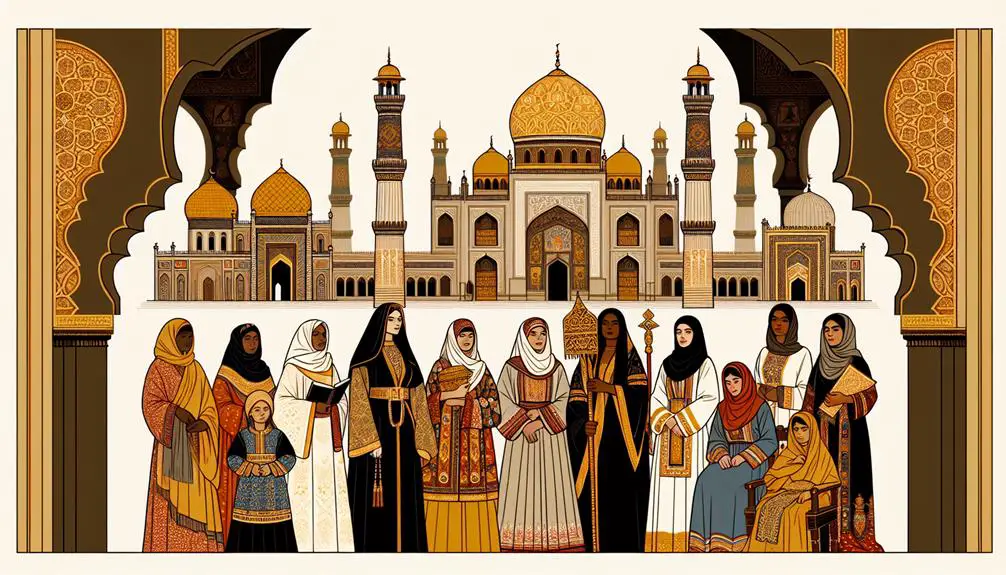
Harems played a crucial role in shaping the political landscapes of ancient biblical societies. They weren't just secluded quarters for royal consorts; they were intricate networks that facilitated the consolidation of power and alliances. Through diplomatic marriages, rulers strategically expanded their influence and secured peace with neighboring territories. These unions often came with trade agreements that not only enriched the kingdoms economically but also ensured a steady exchange of cultural and intellectual wealth.
You'll find that these marriages weren't merely transactions but were imbued with profound political significance. They symbolized the unity between different peoples and served as a tangible commitment to mutual cooperation and peace. Moreover, the offspring from these alliances embodied the physical and political union of their parents' realms, often standing as living symbols of the bond between nations.
Interpretations and Debates
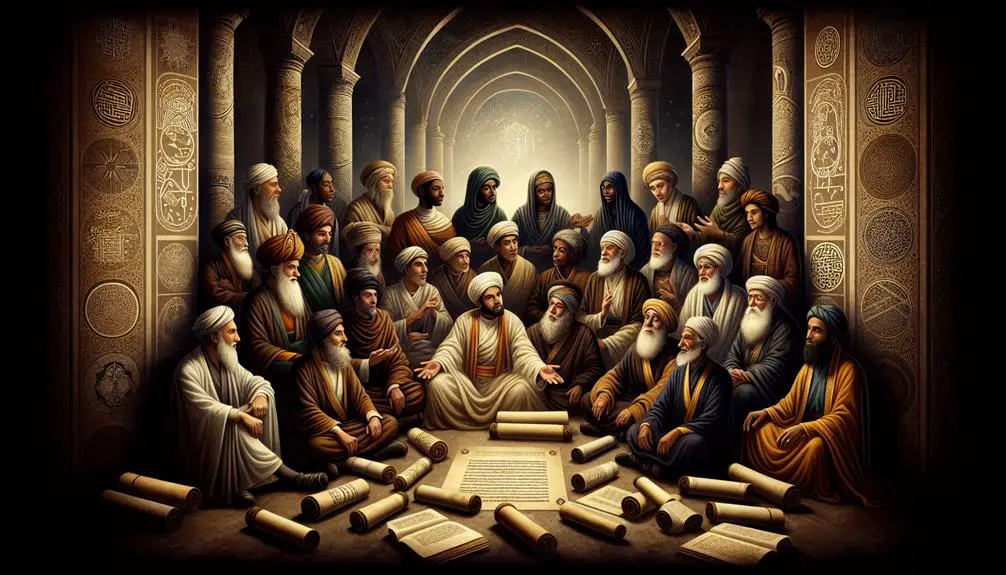
The interpretation of harems within biblical contexts has sparked considerable debate among scholars, focusing on their significance and representation across various narratives. You'll find that these discussions often revolve around a few key points:
- Historical Accuracy: Scholars delve into the historical context of harems to understand their actual role and presence in ancient societies. This exploration helps in separating myth from reality, offering a clearer picture of the past.
- Modern Parallels: The concept of harems is also examined for its modern parallels, where power dynamics and gender roles observed in historical harems are compared with contemporary issues. This comparison sheds light on how ancient practices influence or mirror current societal structures and attitudes.
- Ethical Considerations: Ethical discussions emerge around the portrayal and treatment of individuals within harems. Scholars debate the moral implications of these historical practices, questioning how they should be interpreted or judged by today's standards.
In dissecting these elements, you engage with a scholarly, objective analysis of harems in biblical narratives. This approach not only enriches your understanding of ancient texts but also invites a thoughtful consideration of their relevance and impact on modern society.
Frequently Asked Questions
How Did the Concept of Harem Influence Modern Relationships and Marriage Practices in Cultures Outside the Middle East?
You'll find that the concept of harems has subtly influenced modern relationships and marriage practices beyond the Middle East through the lenses of polygamy psychology and cultural evolution.
These influences manifest in varied acceptance levels of polygamous relationships and have shaped discussions around marital norms and gender dynamics.
Analyzing this evolution helps understand how historical practices inform contemporary attitudes, challenging or reinforcing traditional views on commitment and partnership in diverse cultural settings.
Can Archaeological Findings Provide Concrete Evidence of the Existence and Extent of Harems as Described in the Bible?
Imagine unearthing ancient ruins, where the walls whisper tales of opulence and secrets. Archaeological discoveries, particularly in harem architecture, can shed light on the existence and scale of royal polygamy.
Through meticulous examination of artifacts and structures, scholars can piece together evidence of historical harems. Yet, it's crucial to navigate these findings with an analytical lens, understanding that concrete proof intertwines with interpretative challenges in reconstructing the past's complex social fabrics.
How Have Feminist Theologians and Scholars Critiqued the Portrayal and Treatment of Women in Biblical Harems?
Feminist theologians and scholars have critiqued the portrayal and treatment of women by analyzing gender dynamics and scriptural interpretations. They argue that traditional readings often reinforce patriarchal views, sidelining women's experiences and voices.
You'll find they advocate for a re-examination of texts to uncover and elevate the roles and contributions of women, challenging long-standing interpretations and seeking a more inclusive understanding of biblical narratives.
In What Ways Have Contemporary Movies, Literature, and Art Misconstrued or Accurately Depicted the Biblical Concept of Harems?
Did you know 80% of people absorb history through movies and literature?
When exploring the depiction of harems, you'll find a mix of cinematic accuracy and artistic representation.
Contemporary films often blur the lines between fact and fiction, while literature sometimes leans towards historical truths.
Art, on the other hand, captures the essence but may not always stick to the facts.
It's a complex blend that both informs and misleads viewers and readers.
Are There Any Notable Differences in the Depiction of Harems Between the Hebrew Bible and Its Translations or Interpretations in Other Religious Texts, Such as the Quran?
Yes, you'll find notable differences in how harems are depicted across various religious texts.
The Hebrew Bible and the Quran, for instance, diverge significantly in their portrayal due to contrasting polygamy laws and cultural perceptions.
While both texts address the notion of multiple spouses, their interpretations and implications vary, reflecting broader societal norms and values of their times.
This discrepancy highlights the complex interplay between religion, law, and cultural attitudes towards polygamy.
Conclusion
In sum, the biblical harem, a tapestry woven with threads of politics, power, and personal dynamics, underlines the complexities of ancient social structures.
Solomon's grand harem serves not just as a historical account but as a mirror reflecting the intricate interplay between social norms and individual agency.
As you've traversed through the corridors of time, examining familial ties and political maneuvers, it's clear that these narratives offer profound insights into the human condition, challenging us to scrutinize the fabric of our own societal constructs.

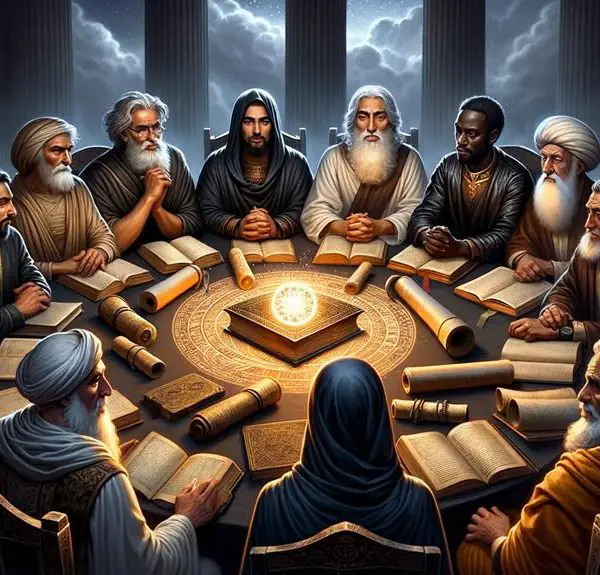

Sign up